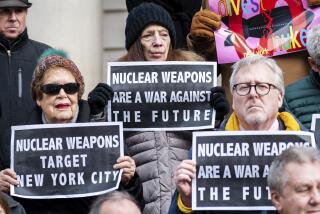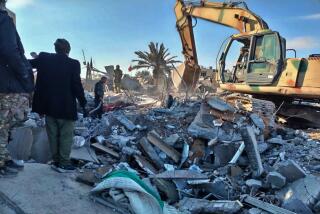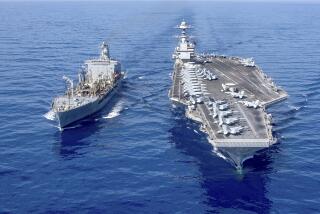Beware the Fatal Attraction of Small Wars
- Share via
In the wake of the INF agreement and other indications of diminished U.S.-Soviet hostility, it has become fashionable among American strategists and policy-makers to emphasize the need for an improved capacity to engage in small regional conflicts--the scattered guerrilla and sectarian skirmishes now dignified by the term “low-intensity conflict.”
Characteristic of this trend is the report of the U.S. Commission on Integrated Long-Term Strategy, released in early January. “In the coming decades,” the report notes, “the United States will need to be better prepared to deal with conflicts in the Third World.” Because such conflicts can arise at any time and in any locale, “the Pentagon must give preference to more mobile and versatile forces.” Similar views have been expressed by other American strategists, including Secretary of Defense Frank C. Carlucci.
Now the trend has begun to emerge as policy: Without waiting to clarify the situation on the ground or to obtain congressional support, President Reagan rushed 3,000 U.S. “quick reaction” troops to Honduras in response to a purported Nicaraguan incursion. These troops included two battalions from the 7th Infantry Division at Ft. Ord, Calif., one of four light infantry divisions created specifically for fast deployment to Third World conflict zones. Termed an “emergency exercise” by White House officials, the Honduras operation was symptomatic of the interventionist approach that we can expect if low-intensity conflicts become top U.S. military priority in the years ahead.
Much of this seems to suggest that there is some sort of universal law of undiminishing global violence--that if the superpowers somehow manage to moderate tensions in the East-West arena, then we must expect a proportionate increase in North-South conflict.
“If Mikhail S. Gorbachev and his policies last,” military author Drew Middleton suggested, “it would appear that we face a period in which our armed forces must be prepared to fight all over the world in relatively minor encounters.”
Naturally, such comments have been well received at the Department of Defense, where there is understandable concern that improved U.S.-Soviet relations will result in diminished military spending. To demonstrate its responsiveness to the new focus on low-level conflict, the Pentagon has established the four light infantry divisions and revitalized the Special Forces, and has sought additional amphibious-assault capabilities.
These initiatives have been accompanied by the development of military doctrine for low-intensity conflict, or LIC (pronounced “lick”). This doctrine draws heavily on the counterinsurgency strategy of the early Vietnam era, but it also builds on lessons learned in the fighting in Central America, the Falklands, Lebanon and Afghanistan. And, while the earlier strategy addressed counter-guerrilla operations only, current LIC doctrine encompasses a much wider range of activities, including “pro-insurgency” (i.e., support for anti-communist insurgents), counter-terrorism, narcotics interdiction and “police” operations of the Grenada type.
At first glance this emphasis on low-level combat appears somewhat reassuring. Instead of focusing on doomsday scenarios and unlikely European contingencies, the Pentagon is finally looking at the common, everyday sorts of conflict that beset the real world. But there is something very deceptive about all this. The adoption of “contingency” plans for limited U.S. intervention in low-level conflicts can unleash pressures for precipitous intervention in local feuds that are best left untouched. What looks at first to be a “minor” affair can easily grow into something far more serious.
To appreciate these dangers, it is worth turning back to the late 1950s, when a number of U.S. strategists expressed similar concerns about the incidence of low-level conflict. In a 1958 report for the Rockefeller Brothers Fund, Henry Kissinger suggested that nuclear retaliation was not an effective deterrent to limited war and that therefore we must “develop units that can intervene rapidly and that are able to make their power felt with discrimination and versatility”--language that bears a striking resemblance to the 1988 strategy report quoted above (of which, incidentally, Kissinger was a principal author).
On the earlier occasion, Kissinger’s advice was greeted with great enthusiasm by the young policy-makers who converged on Washington following the election of John F. Kennedy. The President himself shared this enthusiasm and became a key advocate of counterinsurgency--then enjoying the same sort of faddish popularity now being lavished on low-intensity conflict. In line with this outlook, Kennedy approved a major expansion of U.S. counterinsurgency operations in South Vietnam, thus setting the stage for the massive tragedies to follow.
The danger, of course, is that the current enthusiasm for LIC doctrine will generate a similar propensity for intervention in regional Third World conflicts. Indeed, if we use the Pentagon’s definition of low-intensity conflict, we find that the United States is now (or has recently been) involved in LIC operations in Afghanistan, Angola, Cambodia, Chad, El Salvador, Grenada, Honduras, Lebanon, Libya, Nicaragua, the Philippines and the Persian Gulf area.
With few exceptions, all of these conflicts (and the many others that could invite U.S. involvement in the future) entail a significant risk of escalation. If U.S.-backed counterinsurgency efforts collapse--say in El Salvador or the Philippines--there would be strong pressure in Washington to defend the incumbent government with U.S. troops, as occurred in Vietnam in 1965. Or, if U.S.-backed pro-insurgency campaigns provoke major attacks on countries providing sanctuary for the insurgents--as reportedly occured last week in Honduras--the United States will almost certainly be forced to respond. Even if the United States remains in the background, it is not hard to imagine how an incremental escalation between the local antagonists could draw the U.S. troops into direct military action.
At best, these scenarios would entail direct U.S. involvement in protracted Third World conflicts of the sort encountered in Southeast Asia in the mid-1960s. But the world has changed substantially since 1965, and the belligerents we face in the 1990s may be far better equipped than the Viet Cong and their supporters in North Vietnam. Iran, for instance, possesses a potent arsenal of sophisticated weapons--many of them obtained from Western sources through black-market channels. What starts out as a “low-intensity” engagement could escalate rapidly into something decidedly more destructive.
True, there are still some places left in the world where America can conduct low-intensity operations with a limited risk of escalation. But such locales are disappearing rapidly as the world arms trade puts sophisticated weapons in the hands of all who seek them. However attractive to those seeking an outlet for frustrated Cold War hostilities, therefore, low-intensity conflict is not an arena that America should enter with alacrity.
More to Read
Sign up for Essential California
The most important California stories and recommendations in your inbox every morning.
You may occasionally receive promotional content from the Los Angeles Times.









